Related Research Articles

The Battle of Tannenberg, also known as the Second Battle of Tannenberg, was fought between Russia and Germany between 23 and 30 August 1914, the first month of World War I. The battle resulted in the almost complete destruction of the Russian Second Army and the suicide of its commanding general, Alexander Samsonov. A series of follow-up battles destroyed most of the First Army as well and kept the Russians off balance until the spring of 1915.

The Battle of Stallupönen, fought between Russian and German armies on August 17, 1914, was the opening battle of World War I on the Eastern Front. The Germans under the command of Hermann von François conducted a successful counterattack against four Russian infantry divisions from different infantry corps, which heavily outnumbered them but were separated from each other, creating a gap between the 27th Infantry Division and the 40th Infantry Division, and had little coordination with each other. It was a minor German success, but did little to upset the Russian timetable.

The Siege of Przemyśl was the longest siege in Europe during the First World War. The siege was a crushing defeat of the Austro-Hungarian Army by the Russian Army. Przemyśl was a fortress-town and stronghold on the River San in what is now southeastern Poland. The investment of Przemyśl began on 16 September 1914 and was briefly suspended on 11 October, due to an Austro-Hungarian offensive. The siege resumed again on 9 November and the Austro-Hungarian garrison surrendered on 22 March 1915, after holding out for a total of 133 days.
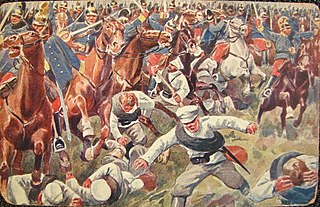
The Battle of Kraśnik started on August 23, 1914, in the province of Galicia and the adjacent areas across the border in the Russian Empire, in northern Austria, and ended two days later. The Austro-Hungarian First Army defeated the Russian Fourth Army. It was the first victory by Austria-Hungary in World War I. As a result, the First Army's commander, General Viktor Dankl, was (briefly) lauded as a national hero for his success. The battle was also the first of a series of engagements between Austria-Hungary and Russia all along the Galicia front.

The Battle of Gumbinnen, initiated by forces of the German Empire on 20 August 1914, was a German offensive on the Eastern Front during the First World War. Because of the hastiness of the German attack, the Russian Army emerged victorious.

The Battle of Limanowa-Łapanów took place from 1 December to 13 December 1914, between the Austro-Hungarian Army and the Russian Army near the town of Limanowa.

Battle of Rawa was an early stage World War I battle between Austria-Hungary and Russia, between September 3–11, 1914. The Russian armies had defeated their opponents and threw them back to the Carpathian mountains. The battle was part of the series of engagements known as Battle of Galicia.

The Battle of Komarow was a battle on the Eastern Front during World War I. It would prove a victory for the Austro-Hungarian forces, but one they would not be able to reproduce in the coming months of the war.
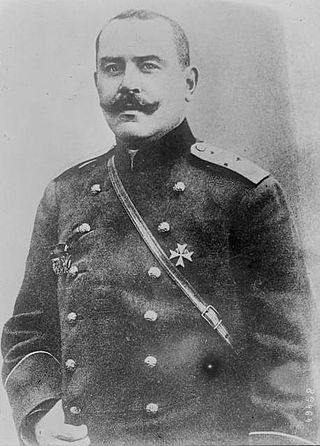
Vladimir Mikhailovich Dragomirov (1862–1928) was a general in the Imperial Russian Army.

Yuri Nikiforovich Danilov Russian: Ю́рий Ники́форович Дани́лов; 13 August [O.S. 1 August] 1866 – 3 February 1937) served as General of the Infantry in the Russian Army during World War I.

Thadeus Ferdinand Ludwig von Sivers, always falsely referred to as Thadeus von Sievers, was a Baltic German general who served in the Imperial Russian Army.

Friedrich (Fritz) Bronsart von Schellendorf was a German officer and politician. He was the chief of Staff of the Ottoman Army and was one of the many German military advisors assigned to the Ottoman Empire. He replaced Otto Liman von Sanders who was assigned to the Aegean region following disagreements with Enver Pasha. He was instrumental drafting initial war plans for the Ottoman Army. Some historians consider Bronsart von Schellendorf to have been complicit in the Armenian genocide. He was also an ardent supporter of Hitler in the 1930s.

Dmitri Pavlovich Parsky was a Russian general of the Imperial Russian Army during World War I, who fought on the Eastern Front.
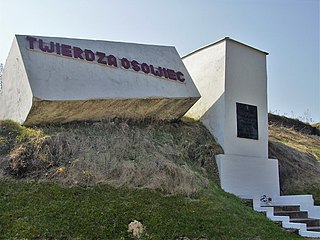

The Battle of Gnila Lipa took place early in the World War I on 29–30 August 1914, when the Imperial Russian Army invaded Galicia and engaged the defending Austro-Hungarian Army. It was part of a larger series of battles known collectively as the Battle of Galicia. The battle ended in a defeat of the Austro-Hungarian forces.

Boje Friedrich Nikolaus von Scholtz was a German general, who served as commander of 20th Corps and the 8th Army of the German Empire on the Eastern Front in the First World War and later as commander of Army Group Scholtz on the Macedonian front.

Karl Freiherr von Pflanzer-Baltin was an Austro-Hungarian general who was active in World War I.
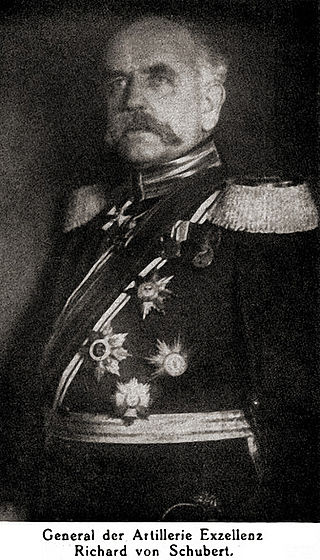
Adolf Louis Theodor Richard von Schubert served as a German army commander during the First World War.
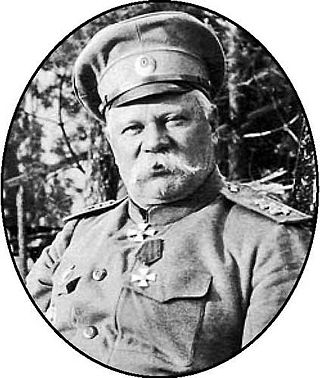
Leonid Vilgelmovich Lesh was an Imperial Russian army commander. He served in China and fought in the war against the Empire of Japan.
The 549th Volksgrenadier Division was a volksgrenadier infantry division of the German Army during World War II, active from 1944 to 1945. It was formed as the 549th Grenadier Division in July 1944 and became a volksgrenadier division several months later. Fighting on the Eastern Front, it was nearly destroyed in the East Prussian Offensive, with its remnants retreating west and surrendering to American troops at the end of the war.
References
- ↑ results, search (19 September 2017). The Splintered Empires: The Eastern Front 1917–21. Osprey Publishing. ISBN 978-1472819857.
- ↑ "HEALTH CRISIS: Retired GP warns of broken system that has little hope of resurrecting itself". Oxford Mail. 20 January 2017.
- 1 2 "3 4 Friday- it's all happening in Abingdon". Mostly Books. 31 May 2013. Retrieved 1 February 2016.
- 1 2 "Dr Prit Buttar". Clinical Options. Retrieved 1 February 2016.
- 1 2 3 4 Ffrench, Andrew (14 June 2013). "Former army doctor's second book on history of war". The Herald. Retrieved 1 February 2016.
- ↑ Wilkinson, Ben (22 September 2010). "Patient's memories inspire Abingdon GP's book on Battleground Prussia". Oxford Mail. Retrieved 1 February 2016.
- ↑ "Collision of Empires". Allen & Unwin Book Publishers. Allen & Unwin Publishers. Retrieved 1 February 2016.
- 1 2 "GP examines an overlooked aspect of First World War in new book". The Herald. 16 June 2014. Retrieved 1 February 2016.
- ↑ "German Ascendant: the Eastern Front 1915". Pritzker Military Museum & Library. Retrieved 1 February 2016.
- ↑ "Out of the Box with Jonathan Russo".
- ↑ Prit Buttar [@Dienekes_] (21 May 2021). "My great uncle was with the Indian Army contingent sent to the Middle East in WW1. Wounded near Baghdad, he had to travel to Basra by mule cart as trains were reserved for white wounded. If telling the whole truth is woke, I'm woke" (Tweet) – via Twitter.